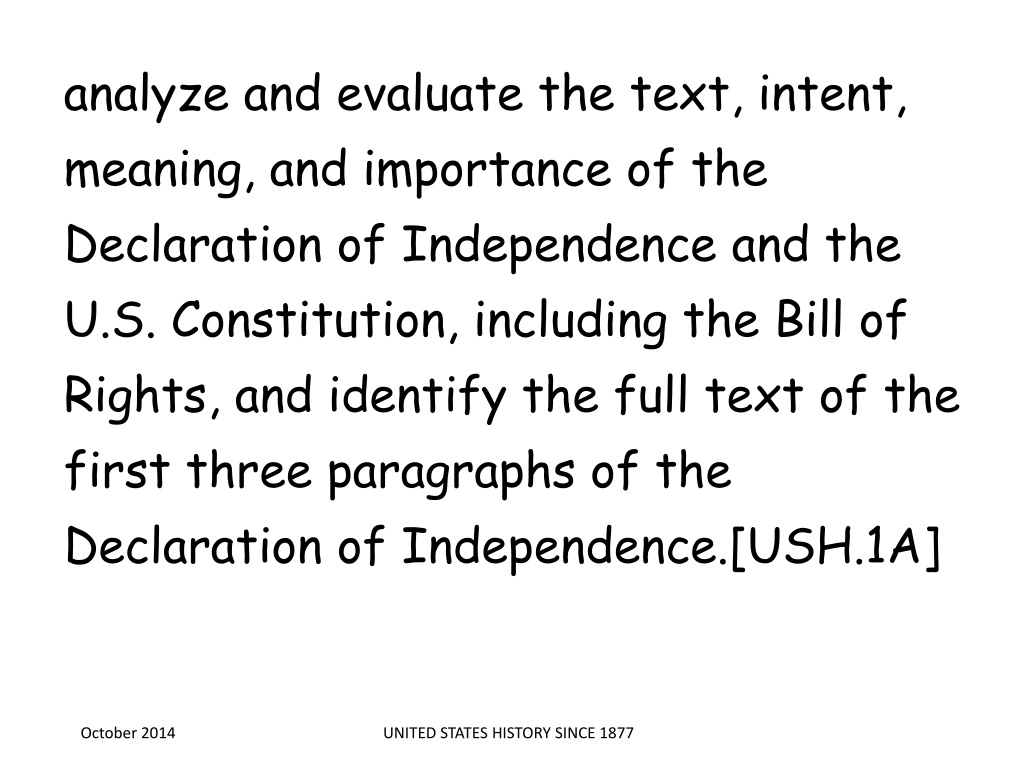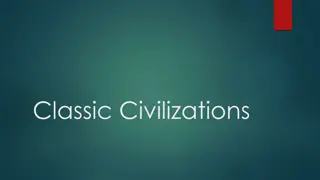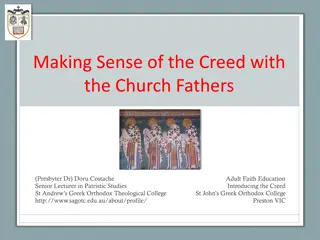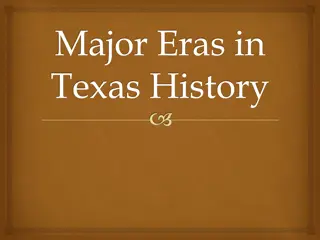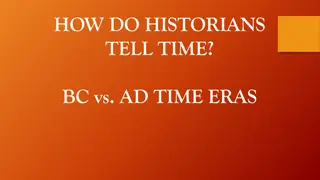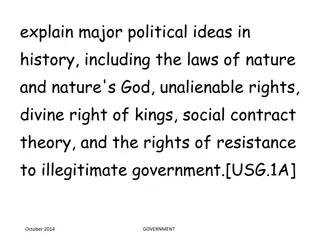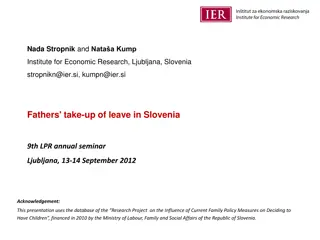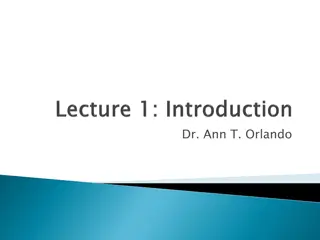Understanding U.S. History: Founding Documents, Founding Fathers, and Major Eras
Explore the significance of the Declaration of Independence, U.S. Constitution, and Bill of Rights, along with the contributions of notable Founding Fathers. Delve into applying founding principles to historical events and identifying major characteristics and eras in U.S. history, from 1877 to the present, including key turning points. Additionally, analyze political issues such as Indian policies, political machines, civil service reform, and the rise of Populism.
Download Presentation

Please find below an Image/Link to download the presentation.
The content on the website is provided AS IS for your information and personal use only. It may not be sold, licensed, or shared on other websites without obtaining consent from the author. Download presentation by click this link. If you encounter any issues during the download, it is possible that the publisher has removed the file from their server.
E N D
Presentation Transcript
analyze and evaluate the text, intent, meaning, and importance of the Declaration of Independence and the U.S. Constitution, including the Bill of Rights, and identify the full text of the first three paragraphs of the Declaration of Independence.[USH.1A] October 2014 UNITED STATES HISTORY SINCE 1877
analyze and evaluate the application of these founding principles to historical events in U.S. history.[USH.1B] October 2014 UNITED STATES HISTORY SINCE 1877
explain the contributions of the Founding Fathers such as Benjamin Rush, John Hancock, John Jay, John Witherspoon, John Peter Muhlenberg, Charles Carroll, and Jonathan Trumbull Sr.[USH.1C] October 2014 UNITED STATES HISTORY SINCE 1877
identify the major characteristics that define an historical era.[USH.2A] October 2014 UNITED STATES HISTORY SINCE 1877
identify the major eras in U.S. history from 1877 to the present and describe their defining characteristics.[USH.2B] October 2014 UNITED STATES HISTORY SINCE 1877
apply absolute and relative chronology through the sequencing of significant individuals, events, and time periods.[USH.2C] October 2014 UNITED STATES HISTORY SINCE 1877
explain the significance of the following years as turning points: 1898 (Spanish-American War), 1914-1918 (World War I), 1929 (the Great Depression begins), 1939-1945 (World War II), 1957 (Sputnik launch ignites U.S.- Soviet space race), 1968-1969 (Martin Luther King Jr. assassination and U.S. lands on the moon), 1991 (Cold War ends), 2001 (terrorist attacks on World Trade Center and the Pentagon), and 2008 (election of first black president, Barack Obama).[USH.2D] October 2014 UNITED STATES HISTORY SINCE 1877
analyze political issues such as Indian policies, the growth of political machines, civil service reform, and the beginnings of Populism.[USH.3A] October 2014 UNITED STATES HISTORY SINCE 1877
analyze economic issues such as industrialization, the growth of railroads, the growth of labor unions, farm issues, the cattle industry boom, the rise of entrepreneurship, free enterprise, and the pros and cons of big business.[USH.3B] October 2014 UNITED STATES HISTORY SINCE 1877
analyze social issues affecting women, minorities, children, immigrants, urbanization, the Social Gospel, and philanthropy of industrialists.[USH.3C] October 2014 UNITED STATES HISTORY SINCE 1877
describe the optimism of the many immigrants who sought a better life in America.[USH.3D] October 2014 UNITED STATES HISTORY SINCE 1877
explain why significant events, policies, and individuals such as the Spanish- American War, U.S. expansionism, Henry Cabot Lodge, Alfred Thayer Mahan, Theodore Roosevelt, Sanford B. Dole, and missionaries moved the United States into the position of a world power.[USH.4A] October 2014 UNITED STATES HISTORY SINCE 1877
evaluate American expansionism, including acquisitions such as Guam, Hawaii, the Philippines, and Puerto Rico.[USH.4B] October 2014 UNITED STATES HISTORY SINCE 1877
identify the causes of World War I and reasons for U.S. entry.[USH.4C] October 2014 UNITED STATES HISTORY SINCE 1877
understand the contributions of the American Expeditionary Forces (AEF) led by General John J. Pershing.[USH.4D] October 2014 UNITED STATES HISTORY SINCE 1877
analyze the impact of significant technological innovations in World War I such as machine guns, airplanes, tanks, poison gas, and trench warfare that resulted in the stalemate on the Western Front.[USH.4E] October 2014 UNITED STATES HISTORY SINCE 1877
analyze major issues such as isolationism and neutrality raised by U.S. involvement in World War I, Woodrow Wilson's Fourteen Points, and the Treaty of Versailles.[USH.4F] October 2014 UNITED STATES HISTORY SINCE 1877
analyze significant events such as the Battle of Argonne Forest.[USH.4G] October 2014 UNITED STATES HISTORY SINCE 1877
evaluate the impact of Progressive Era reforms, including initiative, referendum, recall, and the passage of the 16th, 17th, 18th, and 19th amendments.[USH.5A] October 2014 UNITED STATES HISTORY SINCE 1877
evaluate the impact of muckrakers and reform leaders such as Upton Sinclair, Susan B. Anthony, Ida B. Wells, and W. E. B. DuBois on American society.[USH.5B] October 2014 UNITED STATES HISTORY SINCE 1877
evaluate the impact of third parties, including the Populist and Progressive parties.[USH.5C] October 2014 UNITED STATES HISTORY SINCE 1877
analyze causes and effects of events and social issues such as immigration, Social Darwinism, eugenics, race relations, nativism, the Red Scare, Prohibition, and the changing role of women.[USH.6A] October 2014 UNITED STATES HISTORY SINCE 1877
analyze the impact of significant individuals such as Clarence Darrow, William Jennings Bryan, Henry Ford, Glenn Curtiss, Marcus Garvey, and Charles A. Lindbergh.[USH.6B] October 2014 UNITED STATES HISTORY SINCE 1877
identify reasons for U.S. involvement in World War II, including Italian, German, and Japanese dictatorships and their aggression, especially the attack on Pearl Harbor.[USH.7A] October 2014 UNITED STATES HISTORY SINCE 1877
evaluate the domestic and international leadership of Franklin D. Roosevelt and Harry Truman during World War II, including the U.S. relationship with its allies and domestic industry's rapid mobilization for the war effort.[USH.7B] October 2014 UNITED STATES HISTORY SINCE 1877
analyze the function of the U.S. Office of War Information.[USH.7C] October 2014 UNITED STATES HISTORY SINCE 1877
analyze major issues of World War II, including the Holocaust; the internment of German, Italian, and Japanese Americans and Executive Order 9066; and the development of conventional and atomic weapons.[USH.7D] October 2014 UNITED STATES HISTORY SINCE 1877
analyze major military events of World War II, including the Battle of Midway, the U.S. military advancement through the Pacific Islands, the Bataan Death March, the invasion of Normandy, fighting the war on multiple fronts, and the liberation of concentration camps.[USH.7E] October 2014 UNITED STATES HISTORY SINCE 1877
evaluate the military contributions of leaders during World War II, including Omar Bradley, Dwight Eisenhower, Douglas MacArthur, Chester A. Nimitz, George Marshall, and George Patton.[USH.7F] October 2014 UNITED STATES HISTORY SINCE 1877
explain the home front and how American patriotism inspired exceptional actions by citizens and military personnel, including high levels of military enlistment; volunteerism; the purchase of war bonds; Victory Gardens; the bravery and contributions of the Tuskegee Airmen, the Flying Tigers, and the Navajo Code Talkers; and opportunities and obstacles for women and ethnic minorities.[USH.7G] October 2014 UNITED STATES HISTORY SINCE 1877
describe U.S. responses to Soviet aggression after World War II, including the Truman Doctrine, the Marshall Plan, the North Atlantic Treaty Organization, the Berlin airlift, and John F. Kennedy's role in the Cuban Missile Crisis.[USH.8A] October 2014 UNITED STATES HISTORY SINCE 1877
describe how Cold War tensions were intensified by the arms race, the space race, McCarthyism, and the House Un-American Activities Committee (HUAC), the findings of which were confirmed by the Venona Papers.[USH.8B] October 2014 UNITED STATES HISTORY SINCE 1877
explain reasons and outcomes for U.S. involvement in the Korean War and its relationship to the containment policy.[USH.8C] October 2014 UNITED STATES HISTORY SINCE 1877
explain reasons and outcomes for U.S. involvement in foreign countries and their relationship to the Domino Theory, including the Vietnam War.[USH.8D] October 2014 UNITED STATES HISTORY SINCE 1877
analyze the major issues and events of the Vietnam War such as the Tet Offensive, the escalation of forces, Vietnamization, and the fall of Saigon.[USH.8E] October 2014 UNITED STATES HISTORY SINCE 1877
describe the responses to the Vietnam War such as the draft, the 26th Amendment, the role of the media, the credibility gap, the silent majority, and the anti- war movement.[USH.8F] October 2014 UNITED STATES HISTORY SINCE 1877
trace the historical development of the civil rights movement in the 19th, 20th, and 21st centuries, including the 13th, 14th, 15th, and 19th amendments. [USH.9A] October 2014 UNITED STATES HISTORY SINCE 1877
describe the roles of political organizations that promoted civil rights, including ones from African American, Chicano, American Indian, women's, and other civil rights movements.[USH.9B] October 2014 UNITED STATES HISTORY SINCE 1877
identify the roles of significant leaders who supported various rights movements, including Martin Luther King Jr., Cesar Chavez, Rosa Parks, Hector P. Garcia, and Betty Friedan.[USH.9C] October 2014 UNITED STATES HISTORY SINCE 1877
compare and contrast the approach taken by some civil rights groups such as the Black Panthers with the nonviolent approach of Martin Luther King Jr..[USH.9D] October 2014 UNITED STATES HISTORY SINCE 1877
discuss the impact of the writings of Martin Luther King Jr. such as his "I Have a Dream" speech and "Letter from Birmingham Jail" on the civil rights movement.[USH.9E] October 2014 UNITED STATES HISTORY SINCE 1877
describe presidential actions and congressional votes to address minority rights in the United States, including desegregation of the armed forces, the Civil Rights acts of 1957 and 1964, and the Voting Rights Act of 1965.[USH.9F] October 2014 UNITED STATES HISTORY SINCE 1877
describe the role of individuals such as governors George Wallace, Orval Faubus, and Lester Maddox and groups, including the Congressional bloc of southern Democrats, that sought to maintain the status quo.[USH.9G] October 2014 UNITED STATES HISTORY SINCE 1877
evaluate changes and events in the United States that have resulted from the civil rights movement, including increased participation of minorities in the political process.[USH.9H] October 2014 UNITED STATES HISTORY SINCE 1877
describe how litigation such as the landmark cases of Brown v. Board of Education, Mendez v. Westminster, Hernandez v. Texas, Delgado v. Bastrop I.S.D., Edgewood I.S.D. v. Kirby, and Sweatt v. Painter played a role in protecting the rights of the minority during the civil rights movement.[USH.9I] October 2014 UNITED STATES HISTORY SINCE 1877
describe Richard M. Nixon's leadership in the normalization of relations with China and the policy of d tente.[USH.10A] October 2014 UNITED STATES HISTORY SINCE 1877
describe Ronald Reagan's leadership in domestic and international policies, including Reaganomics and Peace Through Strength.[USH.10B] October 2014 UNITED STATES HISTORY SINCE 1877
compare the impact of energy on the American way of life over time.[USH.10C] October 2014 UNITED STATES HISTORY SINCE 1877
describe U.S. involvement in the Middle East such as support for Israel, the Camp David Accords, the Iran-Contra Affair, Marines in Lebanon, and the Iran Hostage Crisis.[USH.10D] October 2014 UNITED STATES HISTORY SINCE 1877
describe the causes and key organizations and individuals of the conservative resurgence of the 1980s and 1990s, including Phyllis Schlafly, the Contract with America, the Heritage Foundation, the Moral Majority, and the National Rifle Association.[USH.10E] October 2014 UNITED STATES HISTORY SINCE 1877
